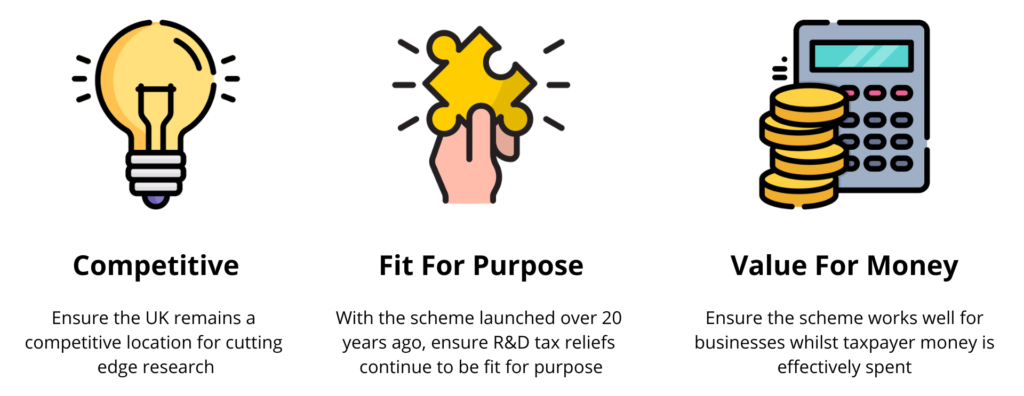- 31st January 2023
- by Libcus
- Uncategorized
HM Treasury Launch R&D Tax Relief Reform Consultation
The UK government recently launched an eight-week consultation on the proposal of a single R&D scheme.
In the Autumn Statement 2022, the Chancellor announced a reform of the UK’s R&D tax relief schemes and a proposal to replace the current SME & RDEC schemes with a single R&D scheme. The consultation, which runs until 13th March 2023, allows stakeholders the opportunity to contribute opinions and ideas on the design of the new scheme.
Find out more details about the consultation, including how you can contribute your opinions below.
Why is the government proposing to reform R&D tax relief?
UK R&D tax relief, which was first introduced in the year 2000, is one of the most generous R&D tax relief systems in the world. Despite this, the level of investment in R&D by UK businesses has lagged other countries for some time. This has declined even further in recent years, largely due to the COVID crisis, economic climate and war in Ukraine.
Businesses will need to increase their investment in R&D to drive future growth, and the government recognises the importance of R&D tax relief in achieving this. The government remains committed to supporting R&D through tax reliefs, increasing the amount of support from £6.7 billion in 2020-21 to over £9 billion in 2027-28. However, there are areas in which it wants to improve the relief to ensure that it remains:

The government has already made some changes to the relief such as the SME PAYE Cap introduced in April 2021. Further changes announced at the Autumn Budget 2021 which focus on modernising qualifying expenditure and tackling fraudulent claims come into effect from 1st April 2023.
The most recent rate changes in the Autumn Statement 2022 align the generosities of the two R&D tax schemes. There is therefore now scope to simplify the R&D tax system and merge schemes into one scheme.
What is the R&D tax relief consultation and what will it discuss?
The reform to the R&D tax relief scheme announced last Autumn is currently under consultation. The two-month consultation, which closes on 13th March 2023, invites views from stakeholders on the design of the potential single R&D tax relief scheme. Stakeholders include UK R&D intensive businesses, representative bodies and accountants who have experience with the existing R&D schemes.
The consultation proposes merging the two current R&D schemes (SME and RDEC) into one scheme – modelling the single scheme on the current RDEC scheme – and suggests ways in which this could be designed and implemented. The consultation will also reflect on responses received from previous consultations including the consultation following Autumn Budget 2021. The government is looking for feedback in the following areas:
- The benefits and limitations of the current RDEC scheme, and whether it is the best platform for a future single relief
- How subcontractor costs would work in a single scheme, given different rules apply to the current SME and RDEC schemes
- PAYE/NI caps – if a cap should be implemented in the new scheme, and how this would work
- The option of additional targeted support for specific sectors, such as green technology
- Timings of the transition to a single scheme and the associated support for businesses during this transition
- The re-introduction of a minimum expenditure threshold, such as the original SME minimum expenditure threshold
How can I contribute to the consultation?
You can take part in the consultation by answering a number of questions. Please click the drop-down below to view the questions in full. You can alternatively choose to submit a general comment, without answering the questions. Comments or submissions should be emailed to RDTaxReliefs@hmtreasury.gov.uk before 2pm on Monday 13th March 2023.
- Do you agree a new scheme should be an above the line RDEC like credit? If not, what alternative would you propose?
- Does the taxability and subsequent different post tax net benefits impact your decision making when allocating R&D budgets?
- If you use RDEC now, is there anything in your view that should be changed?
- Do you agree the same treatment of subcontracting should apply to all claimants in the merged scheme?
- If so, where R&D activity is subcontracted, do you think that the customer should claim the tax relief, as in the SME scheme, or the subcontractor, the person carrying on the R&D, as in the RDEC?
- Can you see any positive or negative impacts on your business or sector from the Government adopting either approach?
- Do you have an alternative model you think could apply all claimants in the new scheme? Please provide qualitative and quantitative evidence with your proposal.
- What are your experiences of the PAYE / NICs cap?
- Are there any ways the Government could simplify the PAYE / NICs cap whilst ensuring there is protection against abuse?
- Which of the SME and RDEC PAYE & NICs cap should the Government implement in the new scheme?
- Should the Government change the way either cap is calculated if is taken forwards? And if so, how?
- Do you consider the government should provide more generous support for different types of R&D or more R&D intensive companies relative to less R&D intensive companies?
- In the event this were to be done, how might this best be achieved within an overall cost envelope?
- If the schemes are merged do you agree the Government should implement the merged scheme on ‘accounting periods starting on or after 1 April 2024? 25
- How can Government ensure SMEs are supported in the transfer into a new scheme?
- Does claiming for expenditure on qualifying indirect activities influence your decision to undertake R&D?
- Do you think a threshold should be implemented? If one was implemented what at what level should it be introduced?
- What is the average amount of R&D expenditure per year per firm in your business or sector?
Once a decision has been made on whether to merge schemes and create a single scheme, the Government’s intention is that if implemented, the new scheme will be in place for accounting periods beginning on or after 1st April 2024.
We will of course keep our website updated with the outcome of the consultation. Visit the news section of our website for the latest updates.

